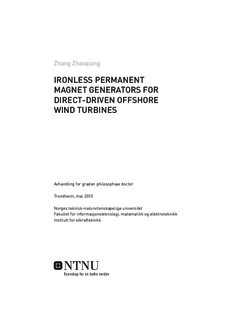| dc.description.abstract | Since the beginning of this century, the offshore wind power industry has witnessed fast
development, as the result of the increasing awareness of climate change and the need for
diversifying power supply. Offshore has vast area available with high wind speed, which
is an ideal place for large-scale wind power exploitation. However, these advantages come
with technological challenges.
One of the key challenges is to develop high-power cost-effective wind turbines with
high reliability. Previous publications have demonstrated the potential of using ironless
permanent magnet generator (iPMG) to reduce the total weight and cost of a wind turbine.
Unfortunately, before the start of the research reported in this thesis, there was no
systematic investigation of the iPMG concepts.
As shown in this thesis, if the traditional direct-driven high-power iron-cored PMG
is used for offshore wind turbines, instead of iPMG concept, a significant amount of the
total weight goes to the supporting structures (inactive parts). The supporting structures
maintain the machine reliability by counter-reacting to various forces, such as the machine
gravity, electromagnetic torque, rotor-to-stator force (for iron-cored machine), rotor-torotor
force (if there are multiple rotors), and force caused by faults. The “secret” of iPMG
roots at the negligible normal stress between its rotor and stator (active parts). By using
non-magnetic material in the stator, the rotor will not exert attracting force on stator.
Having low rotor-to-stator force means lower requirement to the supporting structures,
i.e., the supporting structures can be lightweight and low-cost.
Due to the low air gap field and thus low tangential stress, iPMG has low torque
production. Therefore, iPMG is normally designed with large diameter to produce higher
torque with longer force arm.
Classical machine design theory has concluded that the machine torque is roughly
proportional to its volume. A large-diameter iPMG will therefore have short axial length,
which means small aspect ratio (the machine axial length divided by its outer diameter).
This ring-shape feature requires 3D approach to analyse the magnetic and thermal fields.
Traditionally, it is a common practice to do machine preliminary design and optimization
with analytical methods. The 2D or even 3D finite element method (FEM) is considered
to be accurate but time-consuming, though the performances of computing codes and hardware are being steadily improved. Multi-core computers and distributed-memory
clusters are normally available to most machine designers. Some academic users even
have the access to super computers.
The objective of this research is to investigate the iPMG technologies with the help of
advanced modelling approaches. The main results reported in this thesis are
• An overview of the ironless permanent magnet machines (iPMM) (Chapter 1).
• A comprehensive overview of the generator technologies for operational offshore
wind turbines, the comparison of the efficiencies for different drive trains, and a
review of the new generator concepts (Chapter 2).
• A method for evaluating the goodness of any generator design and predicting the
generator total weight, and a design and optimization strategy for investigating the
weight variation of iron-cored high-power PMGs (Chapter 3).
• A design and optimization strategy for investigating the performances of various
single-stage and multi-stage iPMGs (Chapter 4 and 5).
• A comparison of 10-MW iron-cored PMG and iPMG (Chapter 4).
• A 3D multiphysics design approach where all the calculations are done with open
source codes (Chapter 6).
• An investigation of the machine efficiency improvement with the instantaneous
ABC theory borrowed from power system theory (Chapter 7).
It is also the aim to explore the frontier of machine modelling techniques. In this
thesis, different calculation codes are used, including both open source codes and commercial
codes. The machine modelling covers 1D, 2D, and 3D approaches. The computing
resources used range from ordinary PCs, multiple workstations, a computing server,
and a super computer (tried). To assist this research and other computation-demanding
projects, a scientific computing lab was built with the financial support from the Department
of Electric Power Engineering. The modelling approach was validated with an
existing 23-kW axial-flux iPMG provided by SmartMotor AS.
The main conclusions are: Geared drive trains with induction generators are the dominant
solutions in offshore wind farms. Direct-driven iron-cored PMGs are heavy and
expensive, and most of the weight and cost go to their inactive parts, which makes this
solution not weight-/cost-effective. iPMMs are normally used in low-power (several kW)
high-speed (above 1000 rpm) applications. Using iPMM technology in high-power (e.g.
10 MW) low-speed (e.g. 12 rpm) offshore wind turbines can significantly reduce the
generator cost and weight. It is preferred to build a machine at single stage rather than
multiple stages in terms of torque density and efficiency. For a single-stage iPMG solution,
two-rotor conventional-array PMGs have the optimal performances among all the investigated topologies, and the performance difference between radial flux and axial flux
PMGs gets reduced when their outer diameters are greater than 25 m. Multi-stage solution
may outperform the single-stage solution, if the machine outer diameter is constrained and
the design has multiple objectives. At 10 MW level, a 12-rpm single-stage iPMG with
a diameter of 20 m is lighter and less expensive than a 12-rpm iron-cored PMG with a
diameter of 9.9 m. Even though the state of the art commercial finite-element-analysis
and genetic-algorithm codes are used, and the specially developed design and optimization
strategy can reduce the total calculation time, it takes a week to ten days to solve an
optimization with five free variables. A 3D multiphysics design and optimization strategy
can take into account the effects due to small aspect ratio of iPMGs, and executing such a
strategy with open source codes on a super computer can reduce the computational cost,
but it is still a challenge to parallelize the calculation and optimization. An active shunt
filter controlled with the instantaneous ABC theory can reduce the generator loss, but the
system efficiency is not significantly improved. Nonetheless, it is still attractive to use the
diode rectifier in a converter as a trade-off of cost, reliability, and power yield. | nb_NO |
